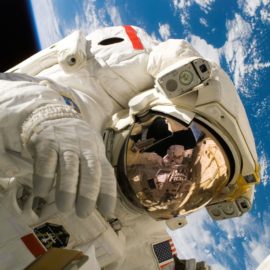

This article is an excerpt from the Shortform book guide to "A Brief History of Time" by Stephen Hawking. Shortform has the world's best summaries and analyses of books you should be reading.
Like this article? Sign up for a free trial here .
What’s Einstein’s theory of time? What’s the difference between special relativity and general relativity?
Einstein’s theory of time encompasses his theories of special relativity and general relativity. In A Brief History of Time, physicist Stephen Hawking aims to explain this to a general audience. He discusses why time is relative as well as the implications of this relativity.
Keep reading for Hawking’s insights.
Time Is Relative
In the same way that the motion of objects and the location where events happen in space is relative to the observer, Hawking argues that different observers may measure time differently. In particular, time appears to slow down for entities that are moving very fast.
Time Is Relative Because the Speed of Light Isn’t
Hawking explains that everyone who accurately measures the speed of light gets the same result, regardless of their particular reference frame, because the laws of physics are consistent for all observers.
(Shortform note: When Hawking refers to “the speed of light,” technically he’s referring to the speed of light in a vacuum. Light slows down slightly when it travels through materials like water or glass. This is what causes refraction of light, where the change in speed at the boundary between two materials causes the light to bend. It also makes Cherenkov radiation possible: Cherenkov radiation is light that is produced when a particle moves through a material (usually water) faster than the speed of light in that material, similar to how an airplane that goes faster than the speed of sound makes a sonic boom. As we’ll discuss, it’s impossible for anything to move faster than the nominal speed of light (that is, the speed of light in a vacuum), but when light itself goes slower through certain materials, particles can sometimes outrun it.)
According to Hawking, this is the case even if the light source is moving relative to you. To illustrate this, first imagine that you’re watching a parade, and someone in the parade throws you a piece of candy. If the parade is moving towards you at three miles per hour (mph), and he throws the candy at 10 mph relative to the float that he’s riding on, then you would measure the speed of the candy at 13 mph, because the speed of the float adds to the speed of the throw. If he waited until after the float passed you, so he was moving away from you when he tossed the candy, you would measure the speed of the candy at seven miles per hour, because then the speed of the float would take away from the speed of the throw.
However, the speed of light works differently than the speed of a physical object. If you measure the speed of light coming toward you from headlights of cars in the parade, and also the light moving away from you from their tail lights, you’ll find that it’s exactly the same: about 186,000 miles per second. This would be the case even if you were watching a parade of starships that flew by at 99% of the speed of light.
Hawking explains that time must be relative because of the relationship between time, speed, and distance. Speed is defined as the distance an object travels in a given amount of time (for example, miles per hour). Since space is relative, time must also be relative for the speed of light to be constant.
For example, imagine two kids playing laser tag on a starship that is traveling at the speed of light. As they fire pulses of light back and forth, from opposite sides of the ship, an observer on the ship measures the distance that the light travels and finds it equal to the width of the ship. But if you’re outside the ship, you would see the light traveling a greater distance. Specifically, the distance would be the hypotenuse of a right triangle, with one leg equal to the width of the ship, and the other equal to the distance the ship traveled while the light was moving across it. Since you perceive the light traveling a greater distance (at the same speed) than the people on the starship, you must also perceive more time elapsing during the event than they do.
The Theories of Relativity
We’ve seen how Newtonian Mechanics implies that space is relative, and how the constancy of the speed of light implies that time is relative. When time progresses at a different rate for one person than another, scientists call this “time dilation.” As Hawking points out, Newtonian Mechanics does not account for time dilation, so Albert Einstein developed his theories of relativity as a replacement for Newtonian Mechanics to remedy this problem. Einstein’s theory of time was introduced in two phases: special relativity and general relativity. Let’s discuss each of these theories in turn.
Special Relativity
First, as Hawking recounts, Einstein developed his theory of special relativity as a model to predict the motion of objects, even at speeds approaching the speed of light. However, he ignored gravity and acceleration to make the mathematical derivation simpler. This allowed him to publish his theory quickly and gain support for it. Hawking notes that French mathematician Henri Poincare published a similar derivation about the same time, which corroborated Einstein’s arguments in support of special relativity.
(Shortform note: “Special Relativity” is “special” because it only works in situations where there is no gravity or acceleration. Physics problems with no gravity or acceleration are simpler, and constitute a “special case,” where a relatively simple theory of relativity can be applied.)
General Relativity and the Curvature of Space
However, scientists needed a more broadly applicable theory of relativity that could account for gravity and acceleration. Einstein spent several years developing his theory of general relativity to meet this need. Like special relativity, general relativity is a theory for predicting the motion of objects that is accurate even for objects moving at speeds close to the speed of light. However, general relativity can model gravity and acceleration, whereas special relativity cannot. In other words, general relativity is more broadly (or “generally”) applicable than special relativity.
As Hawking points out, developing the theory of general relativity required a difficult mathematical derivation, and the key idea that allowed Einstein to complete it was his realization that gravity could be viewed as the curvature of space itself. In other words, general relativity is based on the principle that mass actually causes space to warp, such that the shortest distance between two points is an arc segment, rather than a straight line.
As Newton theorized, an object moving in Euclidean (not curved) space tends to continue moving in a straight line unless a force is applied to it. However, as Hawking explains, if space is curved, then the straight line becomes an arc. The object then continues along a curved path, as if a force were deflecting it, so the curvature of space is equivalent to the force of gravity.
Hawking points out that light also follows the curvature of space, so that, for example, light from a distant star that passes through the gravitational field of another star on its way to earth will bend, making the star appear to be in a different place.
| Testing General Relativity Initially, Einstein’s theory of general relativity was somewhat controversial, mostly because of its implications about the origin of the universe, which we’ll discuss in Question 3. Because of the controversy, it was subjected to even more testing than most theories, and, so far, all the test results have agreed with the predictions of general relativity. Since general relativity is a theory of motion and gravity, most tests of the theory involve using it to predict the motion of astronomical bodies like planets, stars, and black holes (we’ll discuss black holes more in Question 5) and comparing these predictions with observations. The first widely-publicized test of general relativity came in 1915, when Einstein used his theory to predict the orbit of the planet Mercury. He predicted that the orbit would be slightly different from what Newtonian Mechanics predicted—and he was right. In fact, it turned out that astronomers who had been mapping Mercury’s orbit had been puzzled over its deviation from Newtonian Mechanics since 1855. (Some astronomers thought there must be another planet orbiting between Mercury and the sun that was disrupting Mercury’s orbit. They had even tentatively named the hypothetical planet Vulcan, but in 60 years of observations, they never managed to detect it.) More recently, general relativity has been tested using LIGO, the Laser Interferometer Gravitational Observatory, which detects gravity waves. General relativity predicts that since gravity is the curvature of space, massive objects moving through space should create ripples in spacetime. These ripples are called gravity waves. The heavier the objects and the faster they move, the more gravity waves they produce. Researchers at LIGO have observed gravity waves from colliding black holes. These provide a particularly good test of general relativity because the waves are very strong, making them easier to detect and accurately measure. As the black holes collide, their speed also approaches the speed of light, allowing scientists to test the predictions of general relativity at relativistic speeds. So far, the gravity waves from colliding black holes that have been detected have matched the predictions of general relativity. |
Further Implications of Relativity
Time is relative to speed (if you’re moving very fast, relative to someone else, you perceive less time passing than they do), and Einstein developed his theories of relativity to model this phenomenon. As Hawking explains, it turns out that the theories of relativity also imply that mass is relative to speed and time is relative to gravity.
Mass Is Relative
Hawking explains that, as an object accelerates to speeds closer and closer to the speed of light, its mass increases, such that it can never actually reach the speed of light.
As Hawking points out, it takes energy to increase the speed of something, and the more massive it is, the more energy it takes to increase its speed by a given amount. For example, think about a slingshot: When you pull it back, you store a certain amount of energy in the rubber bands. When you release them, the energy is transferred to the pebble in the pouch of the slingshot, accelerating it to a high speed. But if you put a heavier pebble in the slingshot, its speed will be slower, because it would take more energy to accelerate it to the same speed as the lighter pebble.
Hawking explains that, as a consequence of relativity, there is a relationship between energy and mass. This relationship is expressed in Einstein’s famous equation E=mc2, where “E” is energy, “m” is mass, and “c” is the speed of light. Hawking notes that the speed of light is constant, so as energy increases, mass must also increase.
Shortform Note on E=mc²
While it serves to illustrate the concept, the equation E=mc2 does not actually let you calculate the mass of a fast-moving object. The equation for calculating relativistic mass is:
In this equation “m0” is the “rest mass” (mass when the object isn’t moving), “v” is its speed, and “c” is the speed of light.
Note that the change is proportional to the ratio of the object’s speed to the speed of light. You’ve probably never noticed anything getting heavier as it speeds up, because the speeds you encounter in everyday life are so small compared to the speed of light that the change is negligible. For example, suppose you accelerate an airplane truck weighing 100 tons to 1000 mph. At this speed, its mass would increase by about 0.0001 grams.
Why an Object Can Never Travel at the Speed of Light
As Hawking explains, the more energy you apply to something to increase its speed, the more you increase its mass, and the more mass it has, the more energy it takes to further increase its speed. Consequently, it would take an infinite amount of energy to accelerate anything that has mass to the speed of light. (Of course, light doesn’t have mass, which is why it travels at the speed of light.)
| Alternative Explanation Experimental data from particle accelerators conclusively demonstrates that, as the speed of a particle increases, the energy required to further increase its speed also increases, just as the theory of relativity predicts. However, some scientists have argued that this is not because the mass of the particle increases, but rather because the efficiency of energy transfer decays as the speed of the particle approaches the speed of the forces that you’re using to accelerate it. To illustrate this principle, imagine a sailboat that’s initially standing still. When you first hoist the sails and catch the wind, the force of the wind against the sails is strong, and the boat accelerates. However, as the speed of the boat starts to approach the speed of the wind, the wind no longer pushes on the sails as hard, and the acceleration of the boat tapers off. If the sailboat could go the same speed as the wind, then the wind would no longer apply any force to the sails. Similarly, forces like gravity and magnetism travel at the speed of light. You can think of the force applied to an object as a flow of massless carrier particles (photons for electromagnetic forces, gravitons for gravitational forces) from the source of the force to the object. As the speed of the object approaches the speed of light, the amount of force that the force carrier particles can apply to it tapers off. From the standpoint of someone trying to accelerate something to the speed of light, this has much the same effect as if the object’s mass was increasing, since it becomes more difficult to accelerate as it gets closer to the speed of light. But, according to this alternate interpretation, this is because the object feels less force as its speed approaches the speed of the force that’s being used to accelerate it, and its mass actually stays the same. |
Time Is Relative to Gravity
We’ve discussed how motion, space, and even time are relative to your frame of reference, and how the mass of an object also seems to be relative to its velocity. Hawking explains that the theory of relativity also implies that time is relative to gravity.
Specifically, time slows down for people who are experiencing high gravity just like it does for people who travel very fast. Thus, a person living on the top floor of a tall apartment building will age faster than someone living on the ground floor because the person on the ground floor is closer to the earth, where the earth’s gravity is stronger.
(Shortform note: You’ve probably never noticed a difference in the passage of time at high elevation versus low elevation because the difference is very small. There are two reasons for this: First, Earth’s gravity only decreases by about 0.03% per kilometer of elevation that you gain. Second, Earth’s gravity is very weak by relativistic standards, so even the time dilation between zero-gravity and Earth’s gravity is not enough to notice intuitively. However, there are clocks precise enough to measure the difference. In fact, the National Institute of Standards and Technology (NIST) has atomic clocks capable of measuring time dilation with just one foot of elevation difference between them.)
The Nature of Reality
So, is reality relative or absolute? Well, the laws of physics are formulated to be the same for everyone, so they’re absolute in the sense that they’re not relative to the individual. In particular, the speed of light is the same for all observers, regardless of how fast you or the source of the light is moving. However, motion, position, time, and even mass are all relative.

———End of Preview———
Like what you just read? Read the rest of the world's best book summary and analysis of Stephen Hawking's "A Brief History of Time" at Shortform .
Here's what you'll find in our full A Brief History of Time summary :
- The search for a theory that explains the history and evolution of our universe
- Stephen Hawking's discussions about time, space, dimensions, and quantum theory
- How time travel would theoretically work






